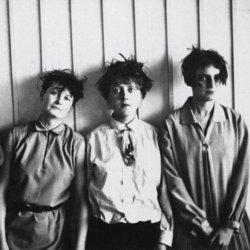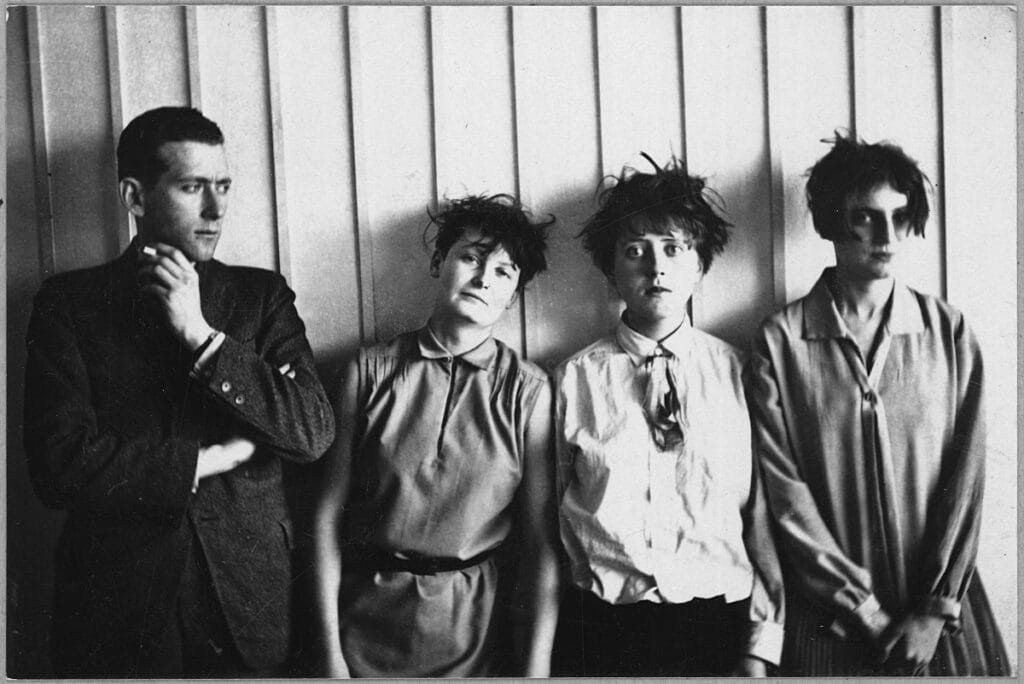[ad_1]
 Late final yr, this picture went viral on social media. It’s of a bunch of Bauhaus design college students from round 1927. They’re known as Martha Erps, Katt Each and Ruth Hellos. The total picture (reproduced under) reveals them with legendary workplace furnishings designer Marcel Breuer, who Erps would later marry. The story of the {photograph} might be discovered right here. On social media, although, the usual response from folks of a sure classic – my classic admittedly – is to recommend that they had been final seen supporting Echo and the Bunnymen on the Barrowland Glasgow in 1984.
Late final yr, this picture went viral on social media. It’s of a bunch of Bauhaus design college students from round 1927. They’re known as Martha Erps, Katt Each and Ruth Hellos. The total picture (reproduced under) reveals them with legendary workplace furnishings designer Marcel Breuer, who Erps would later marry. The story of the {photograph} might be discovered right here. On social media, although, the usual response from folks of a sure classic – my classic admittedly – is to recommend that they had been final seen supporting Echo and the Bunnymen on the Barrowland Glasgow in 1984.
You may argue that they wouldn’t look misplaced now, by no means thoughts the Nineteen Eighties. So the picture raised one other thought for me and it was the topic of a dialog I had not too long ago with Tim Pyne of Footprint+. What’s it concerning the Bauhaus and mid-Twentieth Century design extra usually that also resonates with us? Why is it that so many merchandise designed in that period are nonetheless those we go to after we wish to convey a sure model? Why are our receptions stuffed with Barcelona Chairs? Why are boardrooms stuffed with Eames Aluminium chairs? Cafes stuffed with Ant Chairs?
To show my level, right here’s an fascinating train you could wish to strive. Off the highest of your head and with out fascinated about it an excessive amount of, write down the names of 5 iconic workplace furnishings designs. The type that your Aunt Sheila may recognise if she noticed them however wouldn’t essentially be capable of identify. Once I did this not too long ago whereas writing a chunk about design tendencies, the merchandise I got here up with robotically had been issues like Frank Lloyd Wright’s desks for the Johnson Wax constructing, Motion Workplace, the 3107 chair, numerous Eames merchandise and Breuer’s personal Wassily Chair.
The putting factor was that the final indisputably iconic product I got here up with was the Aeron, and that was launched in 1994. There have been some glorious, even distinctive merchandise on the listing after that date, however they haven’t turn out to be icons and virtually definitely by no means will. It’s a attribute of a real icon that it might probably talk with folks past the commerce. Even these folks most oblivious or blind to the charms of workplace furnishings design know the 3107 because the Christine Keeler chair.
What’s noticeable about every of the merchandise in my very own listing is that not solely are they recognisable to the non-deskhead a part of the inhabitants, not solely have they endured aesthetically, functionally and so commercially over a few years, all of them have opened doorways to a brand new mind-set and all mirrored one thing important about the way in which the world was altering on the time they had been launched. There was usually a motion behind them.
In impact they had been a response to numerous forces that created the evolutionary pressures vital for his or her start. So, you’d assume that given the extraordinary developments in the way in which we work over the previous few years and the higher information we now have that we might have seen the emergence of concepts that had been equally seminal and astonishing.
But we’ve seen little or no in the way in which of iconic concepts for a while now. We had benching, which was fascinating to a big extent and positively of its time, however by no means actually made it as an icon of design and by no means will exactly as a result of it’s so purely useful. We’ve seen top adjustable desks. We’ve seen a complete era of pods, cubicles, rooms and baffles to close out the din and sight of colleagues. We’ve seen essentially the most wonderful dynamic mechanisms utilized to chairs, first with a complete array of controls and now extra generally only one or two.
One of the best of all of those merchandise are invariably designed to make the perfect use of contemporary supplies and manufacturing strategies and have absorbed new data from numerous fields resembling physiology, tradition, anthropology and administration.
So, what has occurred? Où sont les Aerons d’antan? Why is it that we nonetheless really feel the necessity to use Twentieth Century furnishings after we wish to categorical sure concepts in workplace design. Specifically we would ponder why the good icons of modernist design from the center of the century stay so essential after we wish to convey a particular concept and why the traits of their design resonate in additional modern merchandise.
Among the solutions to this query had been maybe set out in this piece from designer Adrian Stokes which argues that our strategy to industrial design is essentially mistaken, with its overemphasis on a sure sort of progress, poor person expertise and attitudes to obsolescence and life cycles. He requires a brand new motion with clearly outlined rules led by the types of corporations which could do one thing about all of it, together with Vitra, themselves the custodians of many mid Twentieth Century icons.
One different fascinating growth that has turn out to be obvious is that there’s a shift in emphasis from producers about the way in which merchandise are taken to market. That is evident in the way in which that collections aren’t simply branded for his or her particular person merchandise, however as a part of a cohesive resolution. Techniques are themed, somewhat than branded. The themes themselves consist not of 1 vary of merchandise, however a set of various merchandise, a few of which aren’t what is perhaps thought of conventional workplace furnishings and a few of which aren’t workplace furnishings in any respect. Apps and analytics are sometimes bundled in.
This transfer to curate options round a theme has additionally led to a bout of acquisitiveness within the market, in addition to higher tie-ups with expertise corporations. Such developments are not possible to provide the types of iconic merchandise we’ll nonetheless be leaning on in future a long time, however they’re an indication of the instances.

Mark is the writer of Office Perception, IN journal, Works journal and is the European Director of Work&Place journal. He has labored within the workplace design and administration sector for over thirty years as a journalist, advertising and marketing skilled, editor and guide.
[ad_2]


